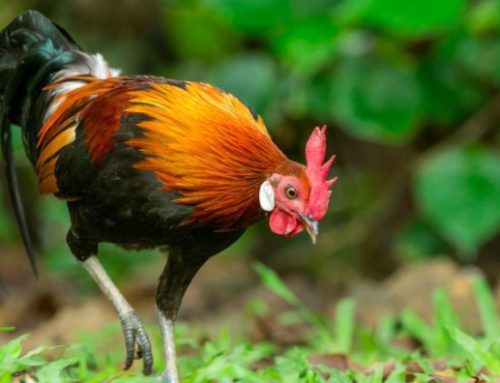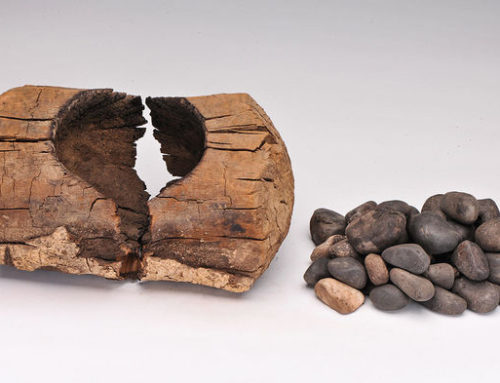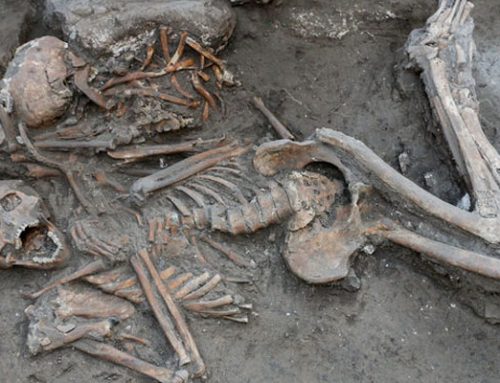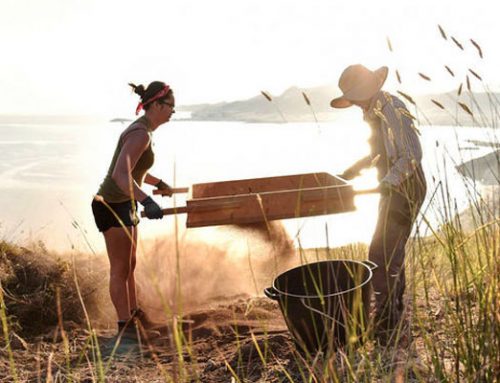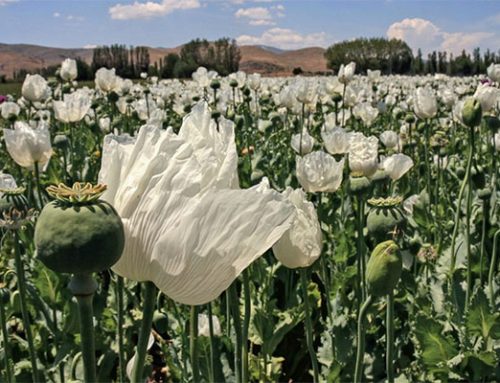Some of the last isolated tribes are emerging from Peru’s rainforests
At first the signs were subtle. A banana tree was stripped of ripe fruit. Papaya and watermelon vanished. A machete went missing. Clothes hanging off a scarecrow disappeared.
The indigenous villagers who hunt and farm manioc in small clearings here already knew they were not alone. The oldest among them remember growing up naked and on the move, living off the bounty of the Amazon rainforest. But their cousins who remained in the jungle typically avoided all contact with outsiders.
Now, the villagers along the muddy banks of the Curanja River, which snakes for 200 kilometers through the rainforest of eastern Peru, are reporting not just signs of the mysterious forest people, but frequent sightings and even raids. “Since 2011, there have been regular incidents with the naked ones,” says Delicia Roque Samuel, 42, speaking in her native Huni Kuin language through an interpreter. Last year, women watched strangers take bananas from their gardens, and a girl picking lemons saw a naked man across the river, motioning her to come with him. When villagers all along the river canoed downstream to vote in regional elections last October, people in three villages returned to find their houses ransacked by isolated people who had previously avoided contact.
Samuel, who lives in the small settlement of Nueva Vida, points to one side of her thatched hut. “They broke this wall, entered, and took pots, pans, clothes, mosquito nets, and hammocks. … We are scared now to go very far, and I’ve planted a garden closer to my house.”
The villagers empathize with their forest-dwelling cousins and say the isolated people “harvest” rather than “steal” goods. But their patience is wearing thin. “The next time,” warns Nolso Torres Prado, head of a village that was abandoned entirely after the October raids, “I will kill them.”
The tension extends beyond this remote corner of eastern Peru. A surge in sightings and raids in both Peru and Brazil may be a sign that some of the world’s last peoples living outside the global economy are emerging. “No one knows what is happening” within these groups, says Francisco Estremadoyro, director of the Lima-based nonprofit ProPurús, which promotes sustainable development in the region. “But there is no question that this is a historic moment.”
Centuries of history show how contact can go wrong. The events along the Curanja are the last, lingering echoes of the collision of cultures that began in 1492, in which an estimated 50 million to 100 million native people perished and entire cultures vanished. Now, anthropologists and officials wonder if they can minimize the human toll of this final act. Lacking immunity to common pathogens and requiring large tracts of intact forest for food, medicines, and materials, the isolated tribes “are some of the world’s most vulnerable people,” says Beatriz Huertas, an anthropologist based in Lima who has extensively studied the groups.
The primary danger is disease transmitted by outsiders such as loggers, miners, missionaries, drug traffickers, and even television crews. These groups threaten tribes and the rainforest on which they depend in other ways, too. In some instances, outsiders have violently attacked isolated peoples. Even well-intentioned gifts like a flashlight —which requires toxic batteries and transforms the night— may disrupt traditional ways of life.
On paper, the solutions seem straight-forward: vaccinations for both forest tribes who emerge and those who contact them, medical care in remote locations, limits on the transfer of modern technologies, and reserves that prevent outsiders from exploiting isolated peoples. But if recent incidents along the Curanja are any guide, the Peruvian government is unprepared to cope with forest people’s emergence in remote corners of the Amazon. “There is a time bomb in the Curanja,” says Chris Fagan, executive director of the Upper Amazon Conservancy (UAC), a U.S. based nonprofit that works closely with ProPurús to preserve ecological and cultural diversity. Adds Estremadoyro: “We are on the threshold of large extinctions of cultures.”
ONE THOUSAND KILOMETERS WEST of the Curanja, across the Andes mountains in Peru’s capital of Lima, cultures hidden deep in the jungle seem like a distant dream or even a fantasy. More than 95% of the country’s population lives in the mountains or along the coast, and until recently government officials dismissed isolated forest peoples as fanciful—a stark contrast with policies in neighboring Brazil.
“The figure of the uncontacted native jungle dweller” is a fiction created by environmentalists eager to halt oil and gas development in the Amazon, Peru’s then President Alan García said in 2007. That same year, Daniel Saba, who headed the state-owned oil company Perupetro, called it “absurd to say that there are uncontacted peoples when no one has seen them.” Carlos Mora Bernasconi, an anthropologist at Peru’s powerful Ministry of Energy and Mines in Lima, insists that other anthropologists and indigenous groups intentionally skew results to stop development.
As reports of contacts proliferate, however, the reality of at least some isolated tribes has become impossible to ignore. In August 2013, some 100 armed members of the Mashco Piro, an isolated tribe that lives primarily in national parks in eastern Peru, appeared near the community of Monte Salvado and made threatening gestures. Then, last fall, some 100 Mashco Piro warriors raided the village while most inhabitants were away, killing dogs and chickens, smashing windows, and destroying clothes. The four remaining community members fled. On 1 May, south of the Curanja and just outside Manu National Park, Mashco Piro men shot an arrow that killed a 20-year-old indigenous villager.
[su_box title=”THE POISONED NECKLACE” box_color=”#666″ radius=”0″]
One day in the early 1950s, when he was a young child living with his family in the Amazon rainforest, Marcelino Pinedo Cecilio encountered his first outsiders. At the sight of light-skinned people who wore clothes, “my mother grabbed me and we ran into the forest,” recalls the 69-year-old.
Not long after, a man whom Cecilio remembers as a German anthropologist visited their isolated village on the upper Curanja River in this remote corner
of the Amazon. (Anthropologists say the visitor may have been ethnographer and photographer Harald Schultz, who worked for what later became FUNAI, the Brazilian governmental agency that protects indigenous people.) “We were naked,” Cecilio says. “He came with machetes, mosquito nets, axes, and clothes.” The visitor stayed 1 night before heading upriver, then returned a couple of weeks later, leaving behind a necklace of fish bones as a gift. Soon after, villagers developed a sore throat and burning fever. Cecilio estimates that 200 people died and the tribe scattered. “We were so weak, and some vanished into the forest.” The tribe blamed the necklace, thinking it was poisoned.
Cecilio remembers growing up in a huge long house with dozens of families. They grew manioc, yucca, peanuts, corn, and jungle potato, sometimes using a root with spines to clear fields. They made arrows using bamboo, sharpening points with the teeth of a large rodent. “We kept good relations with other tribe members who lived in the area, celebrating together and holding competitive games as well,” he says. The brief visit from the outside spelled an end to that life. Like so many indigenous peoples since the arrival of the Portuguese and Spanish here in the 16th century, Cecilio’s group was likely struck down by a common Western disease—maybe influenza or whooping cough—inadvertently carried by the visitor. It is an old story: Within a year of the arrival of Spanish conquistador Hernán Cortés and his smallpox-carrying troops in 1519, for example, half the population of the Aztec capital of Tenochtitlán perished, historians estimate. Today’s isolated tribes are in the same position as those New World peoples 5 centuries ago, with immune systems naive to such pathogens, says Lima-based anthropologist Beatriz Huertas. “They are particularly susceptible to respiratory and eye diseases,” she says.
In the past century, American missionaries, anthropologists, and loggers brought the pathogens. Now, drug traffickers and television crews play that role. In Manu National Park, just south of where Cecilio lives, at least four people of the Matsiguenka forest community died in an epidemic in 2007. A 2008 report
by Peruvian anthropologist Daniel Rodriguez links the illness to a visit by a film crew who wanted to include the Matsiguenka in the popular British series World’s Lost Tribes: New Adventures of Mark and Ollie. Rodriguez concluded that the crew strayed beyond the area included in their permits, which were designed to avoid such transmissions.
The company denied both charges. As increasing numbers of isolated people emerge from the forest, their risk of disease is growing. Finding ways to protect them is an urgent concern anthropologists say.
Today, Cecilio again lives along the Curanja, where he makes feathered headbands and cultivates a garden. This spring, he shared his knowledge of traditional plant medicines with a visiting German biologist.
Despite the bitter memories, Cecilio’s gentle smile radiates kindness. Asked whether he misses his youthful days in the forest, he doesn’t hesitate. “No!” he says firmly. He would like to find a way to talk with the peoples still in isolation. “I want them to know there is another way of life.” ■
[/su_box]
Other regions, such as the mountains of New Guinea and the Andaman Islands in the Indian Ocean, are also home to isolated peoples. But by far the largest numbers are found across the Amazon. And it is in Peru that the situation appears most dire, with large numbers of isolated people—Huertas estimates as many as 8000, scattered in small bands—and a history of neglect.
These are not the uncontacted people of romantic imagination. Most of these groups had traumatic interactions with industrial society about a century ago, when the upper Amazon filled with tens of thousands of outsiders eager to make a fortune from rubber. The difficult and dirty work of tapping the white sap from rubber trees was assigned to indigenous people, who long ago had learned to use the sap to make waterproof shoes or balls. In return, the tribes often received only basic supplies like hammocks, machetes, and clothes; they lived in what amounted to slavery. Scholars estimate that as many as 250,000 natives in Peru and Brazil, or one in 10, died.
Some tribes escaped into the forest, relying on deep knowledge of the ecosystem for all of their needs. They fashioned bows and arrows from local materials to kill game, made poisons to fish, and used diverse plants for medicine and ceremonies. Some groups abandoned traditional skills such as farming and canoe construction in order to avoid detection, Huertas says. She ticks off the forces that may now be forcing isolated people from their hideouts: food shortages, intertribal conflicts, illegal loggers, and oil and gas exploration. Peru is the world’s top producer of illegal cocaine and exports much of it to Brazil, with the remote Amazon jungle serving as a smuggling route. Isolated peoples “are being pushed to the last remnants of intact forest in the headwaters, the most secluded areas,” says ProPurús Director Estremadoyro during an interview in Lima. “They are already in the deepest jungle they can find.”
Peru is at last acknowledging the crisis. “Until a few years ago, the government denied their existence, but now it is finally instituting policies to protect them,” Huertas says. In recent years, the Peruvian government has set aside 3 million hectares in five reserves as safe havens and has forbidden efforts to contact isolated peoples. In a small office she shares with a half-dozen co-workers within Lima’s modernist concrete Ministry of Culture, Lorena Prieto leads the effort to add another five reserves. Teams are in the field now to gather evidence on the location and numbers of isolated peoples—and to understand their emergence. Prieto acknowledges the role of mining and logging, but says “there is something else at play here, though there’s not enough research yet to know what.”

Journeys into the tribes’ last refuges are measured not in kilometers but in turns of the river.
“MALOCA!” SAYS UAC’S FAGAN, his index finger jabbing at the window. “There!” For the previous hour, passengers on a 10-seater charter prop plane have seen only unbroken green jungle and sinuous brown rivers. Now, two clearings, tawny against the emerald foliage, swim into view. Communal thatched huts—malocas—line up in one clearing, while the other appears to be a farm field. Fagan has spotted the settlement of an isolated tribe, far from any known villages—an extremely rare sighting.
After flying over unbroken jungle and rivers for another hour, the plane bumps to a halt in Puerto Esperanza, the capital of Peru’s remote Purús province, which is wedged up against the Brazilian border. A straggling town of fewer than 2000 people unconnected by roads and served only by occasional flights, it is the gateway to the Purús Communal Reserve and the Alto Purús National Park, which border other protected areas. Together, these lands form a Virginia-sized region of tropical rainforest that is home to isolated people as well as threatened and endangered species like pink-hued dolphins, harpy eagles, and black caimans.
Aboard the plane is a team organized by UAC and ProPurús to investigate the recent raids and gauge the villagers’ preparedness for future encounters. The nine-person team includes interpreters for native languages and Rafael Pino Solano, chief of the Purús Communal Reserve. Along with gear and food, the group crams into a motorized canoe christened Lobo del Rio—river wolf—after a giant endangered Amazonian otter. The Curanja River lies a day’s journey from Puerto Esperanza, up the milk chocolate–colored Purús River amid swarms of biting gnats, frequent rain showers, and calls of birds and monkeys in the thick rainforest lining the banks. Distance here is measured not by kilometers but by turns of the wide river.
At Curanjillo, a hamlet of seven families upstream from where the Curanja joins the Purús, villagers worry that isolated people will continue to make off with pans and hammocks. “We know [the tribes] are around, although no one sees them,” explains village chief José Torres Nacimiento, sitting in the open-air community building as women paint traditional designs on visitors’ arms with natural plant dyes. “Things are taken, there are footprints, and you hear animal sounds.” Nacimiento adds that “people feel angry and abandoned” by a government that seems more concerned with the fate of the isolated peoples than with the welfare of villagers who lack electricity, clean water, and health care.
The villagers along the Curanja are themselves only a generation or two removed from a traditional life in the forest. Christian missionaries encouraged them to settle down starting in the 1950s. Now, they keep chickens and grow peanuts, mango, and cocoa beans while maintaining some traditional practices.
A dozen turns upriver in the village of Nueva Vida, a robust 78-year-old elder named Filomeno Torres Marquez recalls that when he was a child, “we were naked, without clothes, or chickens or salt or sugar.” Today, he is just back from a solo hunt for the piglike peccary and a large bird called a curassow—traditional forest staples. In an impromptu demonstration, Marquez pulls out his bow and arrow, both taller than his small but sturdy frame, and demonstrates his mastery by piercing an old shoe several dozen meters away.
Stories of fleeting contact and “harvests” by isolated peoples are echoed in village after village as the group approaches the communal wilderness. Thirteen more turns upriver in Columbiana, a 42-year-old farmer named Maquias Pinero Puricho reports that the isolated peoples appear hungry. “I think these guys don’t have a food safety net, such as farms, so they seek out ours,” he says. Solano notes that in the communal reserve itself, recent floods limited the supply of turtle eggs, a key food for forest peoples in the summer. And the larger of the two main types of peccaries, which usually travel in packs of 100 or more, is in steep decline for unknown reasons. Last year, Mashco Piro tribespeople appeared on the riverbank near the town of Monte Salvado, demanding, “Where did the peccaries go?”
The next village upstream, Balta, boasts a medical post with a nurse, Miguel Silva. But Silva lacks transportation and basic medical supplies, such as antivenom. “Ask the Ministry of Health why I have no boat or motor,” he says. The previous day, a common viper bit the village chief’s 9-year-old son. The chief chose to treat the boy with traditional plant medicines rather than send him a day’s journey downstream to Puerto Esperanza. But when the team offers antivenom, the father relents. The boy ultimately recovers.
Silva also lacks the tools to protect emerging tribes from their biggest danger: infections that can lurk in something as innocent as a cast-off T-shirt. “Most authorities don’t take this problem seriously,” Huertas says. “A cold for us is an inconvenience; for them it can be a tragedy,” she says. Influenza can abruptly wipe out whole tribes. In the 1980s, half of one isolated tribe—some 300 to 400 people—perished after workers for the Dutch oil company Shell passed on pathogens, she says.
 A HALF-DAY’S CANOE RIDE upstream in Santa Rey, the last village before the wilder-ness, Abilio Roque came back from voting in October to find his entire house burned to the ground, including the hunting and fishing gear he uses to survive. The culprit was Epa, a man from an isolated tribe who was enticed out of the forest a dozen years ago by missionaries. Roque had allowed Epa to stay in his house during the elections, and the tribesman later admitted that he had burned it down by accident, according to Roque’s grandson. Known along the Curanja as a man who inhabits a netherworld between isolated and settled people, Epa embodies the tensions brought by this new wave of contact, and some villagers have grown to distrust him.
A HALF-DAY’S CANOE RIDE upstream in Santa Rey, the last village before the wilder-ness, Abilio Roque came back from voting in October to find his entire house burned to the ground, including the hunting and fishing gear he uses to survive. The culprit was Epa, a man from an isolated tribe who was enticed out of the forest a dozen years ago by missionaries. Roque had allowed Epa to stay in his house during the elections, and the tribesman later admitted that he had burned it down by accident, according to Roque’s grandson. Known along the Curanja as a man who inhabits a netherworld between isolated and settled people, Epa embodies the tensions brought by this new wave of contact, and some villagers have grown to distrust him.
The expedition pushes off from Santa Rey and sets off into Epa’s territory, just inside the communal reserve. Accompanied now by a small flotilla of forest rangers and local villagers, the Lobo del Rio ties up along the north side of the riverbank, near where Epa is known to live with his two wives and a mother-in-law. An older woman appears. “Help! My leg hurts—give me a shot,” she wails in the Mastanahua language, falling to the ground in distress. She explains that her name is Maria and that Epa, her son-in-law, has gone to visit his family in the forest. Visitors follow her limping figure about a hundred meters to a makeshift compound hidden in the jungle. Two dozen dogs bark wildly within a palm-fronded shelter strung with small hammocks, one per dog. Dozens of empty turtle shells litter the slope below.
Although Maria’s leg appears slightly swollen, the interpreter says that her distress centers on the recent death of a pet dog and monkey. Her daughter Elena, one of Epa’s wives, ignores the visitors while cradling a sick dog and singing a haunting song. Curious foresters and villagers crowd around, snapping photos with their iPhones. As Maria’s anxiety increases, Fagan calls everyone to withdraw to the boats, to avoid exacerbating a situation that verges on chaos. After camping on a wide beach, the next morning the team heads back downriver. A figure appears on the far bank: Epa himself. He wears a knit cap and a blue and yellow striped shirt and has a small circle of metal cut from a tin can suspended from his nostrils. His eyebrows are shaved, and he looks past middle age. He invites some of the visitors to his compound.
Epa—the name means “father” in the Pano language family—says that his real name is Shuri and that although he has no children, he has 10 family members in the forest. “I often visit my family in the forest, and they often come to visit me here,” he says through an interpreter. His people do not farm or build canoes, he says. He boasts that he recently shot a tapir, a large snouted mammal, taking half to his family, and he proudly shows off his bow and arrow, skillfully made of local wood and fiber.
When asked about the maloca that Fagan saw from the air, he nods. “Those are our enemies,” he says, adding that he fled here in part to avoid their violence. Such clashes among tribes are common and may intensify as the jungle shrinks, anthropologists say.
 Epa says his family is reluctant to join him because game and fruit are scarce nearby. “We need cooking oil, sugar, salt, knives, machetes, tobacco, and clothes. If you give me plenty of these things—all the things you use in town—then my relatives might move here. … Maybe if there were a large house and a farm to support us, then they might come and settle down.”
Epa says his family is reluctant to join him because game and fruit are scarce nearby. “We need cooking oil, sugar, salt, knives, machetes, tobacco, and clothes. If you give me plenty of these things—all the things you use in town—then my relatives might move here. … Maybe if there were a large house and a farm to support us, then they might come and settle down.”
He offers to exchange a large turtle and two small ones for staples and flashlights. Fagan trades the animals, which are later released in the river, for rice, sugar, and oil. “I know you won’t give me the flashlights,” Epa grouses, his eyes straying to the photographer’s camera gear.
At the mention of the October raids, Epa grows wary. “Yes, some of my family members were involved,” he admits. “But the timing was just coincidence. I didn’t know everyone would be gone.” But the Curanja villagers say that Epa knew all about the elections. They suspect that he is much more than a naive native seeking safety, sugar, and salt. He is, they believe, studying them as carefully as any anthropologist, noting the ripening of orchard fruits, the quantity of their goods, and their daily movements. He may be, in effect, a spy.
“I’ve been analyzing the encounters with isolated people since Epa’s arrival around 2002,” says Tomas Torres Alicio, a 61-year-old schoolteacher back downstream in Columbiana. “There have been 15 or so incidents, almost all on the north bank of the Curanja. … He must be telling his family details about our farms and goods, and when we are absent.” Whatever Epa’s precise role in the incidents, he is an agent of contact, and Fagan worries that he may transmit pathogens back to his people in the jungle.
Some villagers and even government foresters lack the dozen or so vaccinations recommended to protect isolated peoples, says reserve chief Solano. Missionaries say that Epa, Maria, and his wives refused vaccinations a decade ago; whether they have been vaccinated since is not clear. “He and his family have consistent contact with their tribe, which still lives in isolation and have not received any immunizations, as well as with nearby villagers who travel to cities, and even with the occasional outsiders who visit the Curanja,” Fagan says. “Disease transmission is a significant and immediate threat.”
Epa’s story shows the need for better planning and health care in these remote regions, Huertas says. “You can’t take them to a town,” she says of the tribespeople. “You need a small group of specialists to isolate them from villages.” This would entail building small centers on the reserve perimeters, as is done in Brazil, to serve as a base for treating or helping isolated people.
Back at the Ministry of Culture in Lima, Prieto acknowledges the need. “We respect the right of the people to be isolated, and we are also pushing to provide health care assistance.” But with an annual budget of only $1 million, her 17-member staff is stretched thin. “There is no way to cover this amount of territory on our budget,” she says. The government has yet to agree on health protocols for the isolated peoples, much less on the funding to put Prieto’s vision into place. Meanwhile, anthropologists agree that more research is desperately needed to understand just why tribes are emerging now.
If isolated people do manage to avoid epidemics, the loss of land, and violence by hostile outsiders, they may find little comfort in the struggling villages along the Curanja. These villagers themselves have yet to reap many of the benefits of modern civilization, including electricity, clean water, or employment opportunities. “After initial contact, these people are often left to their fate, struggling to survive, cut off from other groups, begging for food, and with no land to call their own,” Huertas says. Faced with a shrinking habitat and an influx of outsiders, however, the tribes’ time for choosing between the forest and settled life may be drawing to a close as abruptly as the tropical dusk. ■




